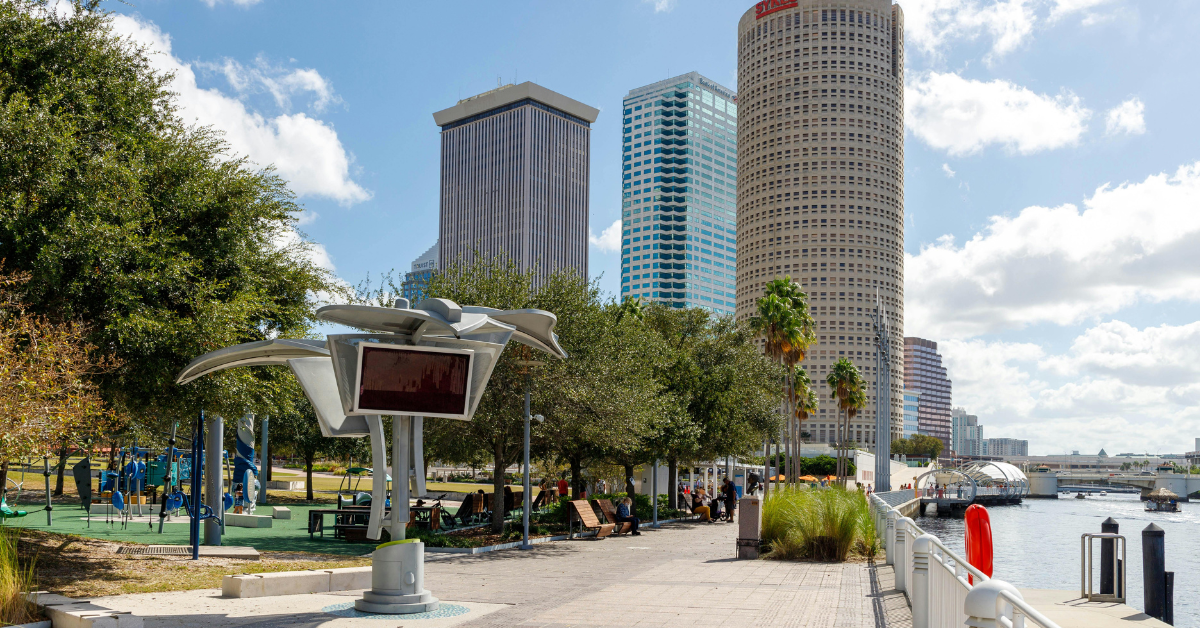Making the Move to Tampa: Your Sunshine State Relocation Checklist

Starting fresh in a new city is always an adventure—and with the right plan, your move can be just as exciting as your destination.
If you’ve chosen Tampa as your new home, you’re in for year-round sunshine, vibrant neighborhoods and a thriving mix of culture, opportunity and coastal charm. From stunning waterfront views to a strong job market, the city truly offers something for everyone—whether relocating for work, family or a fresh start.
This guide provides a complete relocation checklist to help make your transition smooth and stress-free. From researching neighborhoods and choosing the right movers to settling comfortably into your new home, you’ll find everything you need to start your Tampa journey confidently.
Key Takeaways
- Tampa offers sunshine, diverse neighborhoods and strong job opportunities.
- A relocation checklist keeps your move organized and stress-free.
- The right moving and storage solutions simplify your next move.
- Focus on essentials, schools and new friends to settle in smoothly.
Why Move to Tampa, Florida?
Tampa offers something for everyone, whether you’re drawn to its sunny climate, thriving economy or one-of-a-kind quality of life.
Here’s why so many people choose to call it home:
Location & Lifestyle
Tampa is a vibrant metropolitan area on Florida’s west coast, set along Tampa Bay and just minutes from the Gulf of Mexico. Known for its year-round sunshine, palm-lined streets and relaxed pace, the city attracts those who want to enjoy the outdoors without giving up big-city amenities.
From waterfront living to walkable downtown areas, Tampa offers a balance of comfort, convenience and coastal beauty that makes everyday life feel like a getaway.
Diverse Neighborhoods
Choosing where to live is one of the most exciting parts of relocating to Tampa. The city’s neighborhoods cater to a variety of lifestyles:
- Downtown Tampa – Ideal for professionals who want to be close to offices, restaurants and entertainment.
- Ybor City – A historic district with Cuban heritage, lively nightlife and colorful architecture.
- South Tampa – Trendy and upscale, with excellent schools and access to scenic Bayshore Boulevard.
- Westchase – A family-friendly suburb with parks, golf courses and a strong community vibe.
- Davis Islands – A waterfront neighborhood with a small-town feel just minutes from downtown.
Strong Economy & Job Market
Tampa’s economy is growing rapidly, with industries such as finance, shipping, telecommunications, healthcare, tourism, insurance and real estate all thriving. Major employers include BayCare Health System, Publix Super Markets and the University of South Florida. The city is also building a strong reputation as a hub for tech startups and innovation.
Rich Cultural Heritage
Tampa’s history is woven from many influences. Native American tribes, Spanish settlers and Cuban immigrants have all left their mark on its culture, cuisine and traditions. This heritage is celebrated at events like the Gasparilla Pirate Festival and in Ybor City’s cigar shops and Latin cafés.
Cost of Living & Quality of Life
Compared to other large U.S. cities, Tampa offers a relatively affordable cost of living. Florida’s lack of state income tax appeals to many newcomers and housing remains competitively priced, particularly in suburban areas. With world-class beaches, professional sports teams and a rich arts scene, Tampa offers an enviable balance of affordability and lifestyle.
Your Tampa Relocation Checklist
A smooth move to Tampa starts with preparation and organization. Use this step-by-step checklist to stay on track, reduce stress and start enjoying your new Sunshine State lifestyle right away.
1. Research the Best Neighborhoods in Tampa
Explore communities that match your lifestyle and budget. Consider:
- Commute times to work, school, or the beach
- Local school ratings and proximity to universities
- Availability and quality of nearby preschools, elementary, middle and high schools
- Walkability and public transportation access
- Proximity to grocery stores, healthcare and recreation spots like parks or the Tampa Riverwalk
If possible, visit neighborhoods in person to understand the community. If you’re planning from afar, use virtual tours, online forums and local social media groups to gather insight.
2. Set Your Moving Budget
Account for all expenses, including:
- Moving company fees
- Packing supplies and moving boxes
- Truck rentals or fuel
- Temporary storage units
- Utility deposits and connection fees
- Professional cleaning services for your old place or new home
Don’t forget upfront housing costs, like a security deposit if you rent. Build in a buffer for unexpected expenses so your finances stay on track.
3. Choose a Moving Date
Tampa’s weather can influence your schedule. Summers bring heat, humidity and daily afternoon showers, while spring and fall often provide cooler, drier conditions—ideal for moving. Also consider:
- Work schedules and vacation time
- Children’s school calendars
- Housing or lease start dates
4. Hire Professional Tampa Movers
The right moving team can make your transition much easier. Start researching local Tampa movers early, request a few free quotes and compare options so you can book the team that best fits your needs and timeline.
5. Start Packing & Labeling Early
Begin with non-essentials like seasonal clothing, holiday décor or books. Use sturdy boxes and label each with:
- The destination room
- A brief description of contents
- “Fragile” markings for delicate items
Color-coded labels can make unpacking even faster. Don’t forget to set aside essentials like toiletries, chargers and house keys so they don’t get packed away by accident.
6. Notify Service Providers
At least two weeks before moving day, arrange for utility transfers and update your address with:
- Electricity, water, gas and internet providers
- Subscription services
- Insurance companies and banks
- The U.S. Postal Service for mail forwarding
7. Handle Important Documents
Keep essential records safe and within reach:
- Medical records and dental files
- School transcripts
- Birth certificates, passports and IDs
- Vehicle registration and insurance documents
Store these in a folder or secure digital file that travels with you, not in the moving truck.
8. Prepare for Moving Day
Make moving day seamless by:
- Confirming all details with your movers a few days ahead
- Packing a “day-of” essentials bag with snacks, water, medications, chargers, toiletries and a change of clothes
- Arranging pet or plant care so they’re safe and comfortable
- Doing a final walkthrough of your old place to ensure nothing is left behind, returning house keys to your landlord and collecting your security deposit if applicable
- Confirming you have essentials like your driver’s license, important documents, the moving manager’s contact information and any planned stops along the way
Choosing the Right Moving Partner
Selecting the right moving company is one of the most important steps in your relocation. The movers you choose will greatly affect how smoothly you transition into your new home.
Depending on your moving needs, here are a few things to keep in mind when selecting your partner:
- Check Credentials: Ensure the company is licensed and registered with the appropriate state or federal agencies. This protects you in case of loss or damage.
- Local Knowledge: A mover familiar with Tampa’s neighborhoods, parking restrictions and seasonal weather patterns can plan your move more efficiently.
- Compare Services: Beyond basic transportation, find out if they offer packing/unpacking assistance, short- or long-term storage and other services such as specialty moving for pianos, antiques or valuable artwork.
- Read Reviews & Ask for References: Online reviews and word-of-mouth recommendations provide insight into customer satisfaction and reliability.
- Get a Free Estimate: Request written estimates from at least three movers and make sure they include all potential charges—no hidden fees.
- Evaluate Communication: Choose a mover who responds promptly to your questions and provides clear instructions. A responsive, organized company is often a reliable one.
Moving and Storage
A full-service moving company can offer more than just transporting boxes—they often provide flexible storage options to make your move easier. If there’s a gap between moving out of your current home and into your new Tampa residence, short-term storage can keep your belongings safe and accessible.
Storage solutions can be especially helpful in Tampa for:
- Families building a new home need a secure place for their furniture until construction is complete.
- Downsizing retirees who want to keep extra furniture or personal items without cluttering their new space.
- College students at the University of South Florida or the University of Tampa who need short-term storage during summer break or study abroad programs.
Comprehensive movers often bundle moving and storage services, saving you time, money and the hassle of coordinating with multiple providers. Having everything handled by one trusted partner ensures a smoother, more organized relocation.
Settling into Your New Tampa Home
Once the boxes are unloaded, it’s time to turn your new place into a comfortable, functional home. Start by focusing on the essentials to settle in quickly and stress-free.
- Unpack Priority Items First – Begin with kitchen supplies, toiletries, bedding and other daily necessities so you can cook, clean and rest comfortably right away.
- Update Your Address Promptly – Notify the USPS for mail forwarding and update your information with banks, healthcare providers, insurance companies and any memberships or subscriptions to avoid missed bills or appointments.
- Help Kids Transition to a New School – If you have children, confirm their enrollment, meet with teachers or school administrators and help them get familiar with their new campus and routines.
- Get to Know Your Neighborhood – Start by locating nearby grocery stores, pharmacies and other everyday conveniences. Take a walk or short drive to explore local parks, restaurants and coffee shops and look for opportunities to join community events or groups where you can make new friends.
- Tackle Quick Maintenance Tasks – Change door locks for security, test smoke and carbon monoxide detectors and check that all appliances and utilities are in working order.
Start Your Tampa Adventure with Confidence
Moving to Tampa is more than just a change of address—it’s the start of a new chapter in a city filled with opportunity, sunshine and community spirit. The key to a smooth transition is preparation. With a well-structured relocation checklist, you’ll stay organized, avoid common pitfalls and ensure every detail is covered.
With the right plan and team, you can feel confident about your next move and focus on enjoying everything Tampa has to offer.
Ready to take the next step? Discover how Armstrong’s household relocation services handle everything—from careful packing and secure transport to efficient unpacking—so you can settle in quickly and explore your new hometown.


